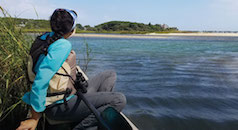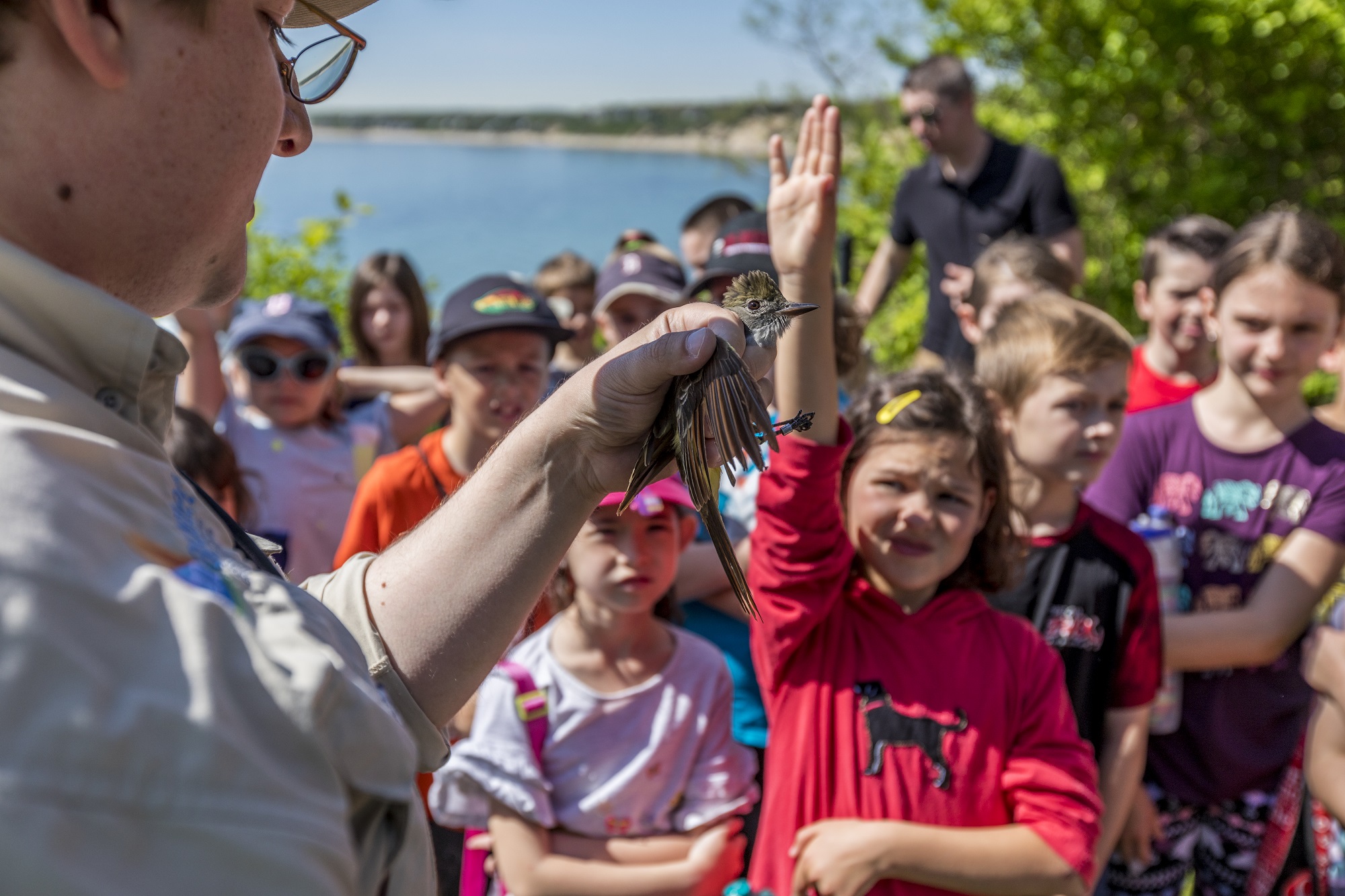Search Results

Gulf Coast Whimbrels, Spring 2021
Whimbrel (Numenius phaeopus) have been identified as a conservation priority in the Atlantic Flyway, with a population that has declined by 50% between the early 1990s and the mid-2000s at key Atlantic staging areas. Manomet, along with the Center for Conservation Biology at William & Mary and many other partners are working together to gather all the information we need to apply conservation action to Whimbrel populations. In April 2021, Manomet’s Brad Winn and I headed to the Gulf coast to expand our recent work in the Atlantic flyway into the Midcontinent Flyway. Our goal for this trip? To delineate key staging areas for Whimbrel in Louisiana and Texas and build relationships with the key conservation players. Why are we...
Shrimp and Shorebird Conservation
Many thousands of acres of shrimp farms have replaced areas of natural coastal habitat — mostly salt-pan flats and mangrove forests — which are critical areas for shorebirds in Mexico, Central America, and northern South America. As long-distance migrants, shorebirds connect the Arctic with Argentina’s Tierra del Fuego along the Pacific Flyway, and the east coast of the United States to the Pacific coast of Central and South America. On all of these routes, shorebirds face distinct threats that require a coordinated response by different stakeholders throughout the hemisphere who work together to connect conservation with sustainable development. By working with shrimp farmers, we provide significant benefits for shorebirds and other species. Our partners at Quetzalli Nicaragua have been generating...
Flyways
Safeguarding the health of birds Manomet is best known for its work on avian species and is arguably the world leader in shorebird conservation. We are working to grow the impact of this work through enhanced monitoring, expansion of on-the-ground site conservation, a strong focus on working lands and seas, and enhanced partnerships. Many shorebird species use habitats across a vast geography, undertaking some of the longest migrations in the animal kingdom. They are also one of the bird groups undergoing the steepest declines. The total geographic area used by a species or population during its annual lifecycle is termed a flyway. Within each flyway, shorebirds tend to concentrate at just a few sites that provide safe foraging and resting...
Tracking Whimbrel: Journey with these shorebirds on their non-stop flight from Cape Cod to South America
From July through late September, Whimbrels migrate southward from their sub-Arctic tundra breeding grounds to Cape Cod, Massachusetts. While on the Cape, this large shorebird spends up to several weeks in the saltmarshes feeding on fiddler crabs—an important staple of their diet. After replenishing their energy reserves, building fat reserves and flight muscles, these Whimbrels will make a non-stop, trans-oceanic flight to their wintering grounds in the Caribbean Islands or all the way to the north coast of South America. These Whimbrels need to overcome many challenges on their long journey, ranging from natural predators to a myriad of human-made threats. Join us for a webinar on Thursday, January 14, with Manomet’s Alan Kneidel and Brad Winn, Mark Faherty, staff...
Make A Difference
With the unequivocal warming of our climate and alarming threats to Earth’s biodiversity, science has never been more important, and neither has your support for Manomet and our work. For more than 50 years, Manomet has been using science to make our world a better, more resilient place. It’s why we’re in the Arctic researching shorebird decline and working with partners throughout the Americas to protect their habitat. It’s why we’ve operated our banding lab since 1969, collecting 50 years of valuable migration data used by scientists around the world. It’s why you’ll find Manomet in Maine’s small towns working to restore fisheries, and in rural communities throughout North America helping to prepare forests for the effects of climate change....
Whimbrel Migration: Summer 2020 Update
Whimbrel migration is in full swing! From July through late September, Whimbrel migrate southward from their Arctic and sub-Arctic breeding grounds and some spend up to a month with us along our coast. While in Massachusetts, Whimbrel spend almost all of their time in the saltmarshes feeding on fiddler crabs—an important staple in their diet. After replenishing their energy reserves, Whimbrel in Massachusetts will typically make a non-stop, trans-oceanic flight to their wintering grounds in the Caribbean Islands or all the way to the north coast of South America. Manomet’s Shorebird Recovery team is excited to share an update on what “our” satellite-transmittered Whimbrel have been up to over the last few months. These birds’ stories continue to help us...
Webinars
Want to learn from Manomet's staff and partners? Watch one of our webinars! Our scientists and experts explain the mysteries of why birds migrate, the importance of river herring in coastal food webs, and so much more. Attend future webinars listed under "Upcoming Virtual Programming", or catch up with recordings of previous webinars! Stay up-to-date with Manomet's events and conservation news stories by joining Manomet's e-news.
Connecting Art to Science: A lens on shorebird conservation
Thank you for joining us in Concord for our event, “Connecting Science to Art: A Lens on Shorebird Conservation.” We are pleased to be able to offer you an extended opportunity to purchase the photos that were on display that evening. This is a rare chance to purchase the beautiful photographs taken by our scientists Brad Winn, Shiloh Schulte, and Alan Kneidel and to directly support the work of Manomet’s Shorebird Recovery Program. Orders will only be accepted through Wednesday, November 27, and finished prints will be available for pickup at our printing partner, Pitch Black Editions in Concord, the second week of December. You may also arrange for shipping if you'd prefer. You will receive an email once your order is...
Tracking Whimbrels for Conservation Action
Many populations of large, migratory shorebirds, including Whimbrels and other curlew, are experiencing significant declines at a global scale. These declines can be attributed to individual threats such as unregulated hunting on their wintering grounds, but most declines are the result of cumulative threats throughout the migratory life of each bird. Our local curlew, the one that frequents eastern Massachusetts in the late summer and fall, is called the Whimbrel (Numenius phaeopus). Manomet is studying Whimbrel migrations to help understand where and when conservation actions are needed to improve the life-supporting conditions on the ground for this and all shorebirds. From July through late September, Whimbrels migrate southward from their Arctic and sub-Arctic breeding grounds and some spend up to...
A reflection for World Curlew Day
When I plug my pen drive into the car radio, often the first thing I hear is the haunting “cour-lee” of a Slender-billed Curlew Numenius tenuirostris. This flight call is doubly haunting: It’s the only known recording of the species; and it’s a species I will never have the chance to hear in real life. The last accepted record of the species was in Hungary in 2001, and it is increasingly considered to be globally extinct. Unfortunately the Slender-billed Curlew is not alone in slipping away before our eyes. Of the eight species of curlew Numenius in the world, five are considered globally at risk of extinction according to the IUCN Red List. And within the Americas, the four regularly...



